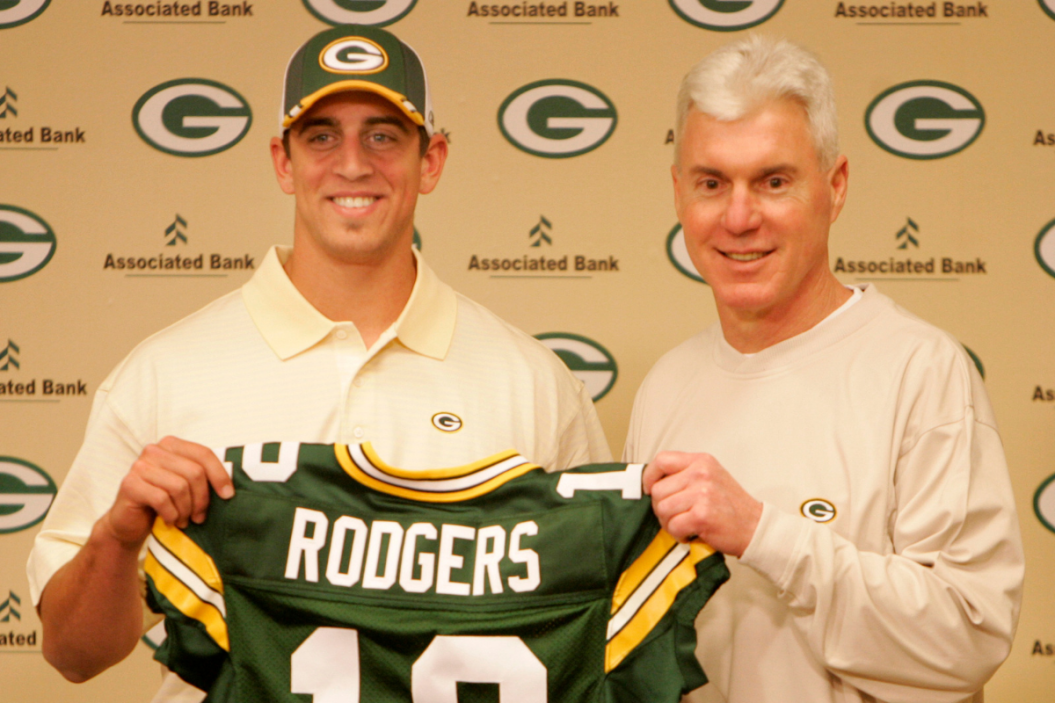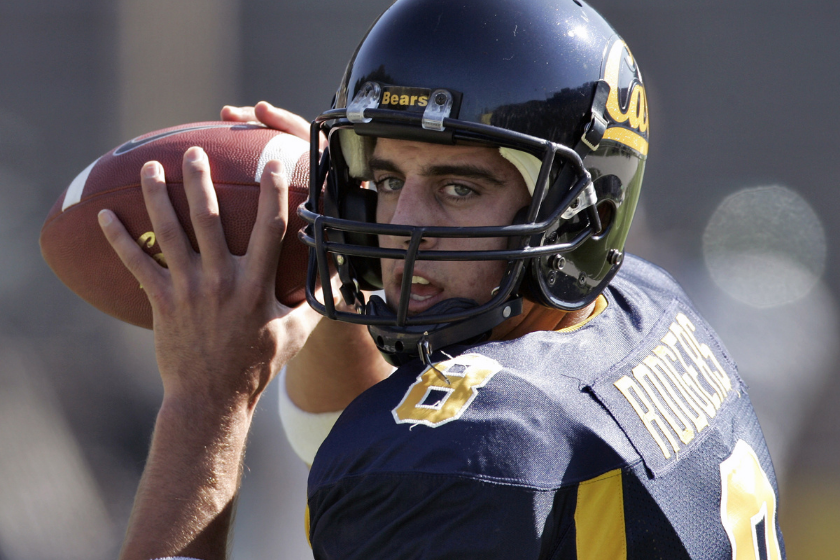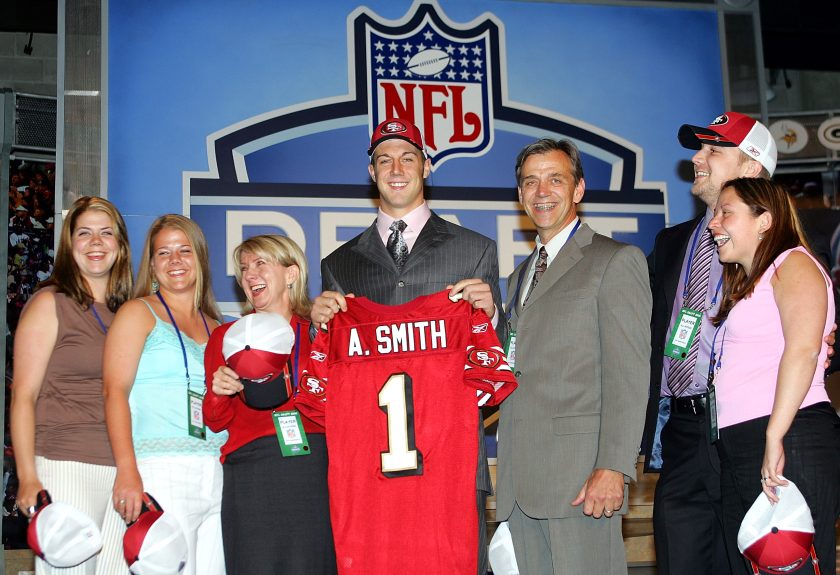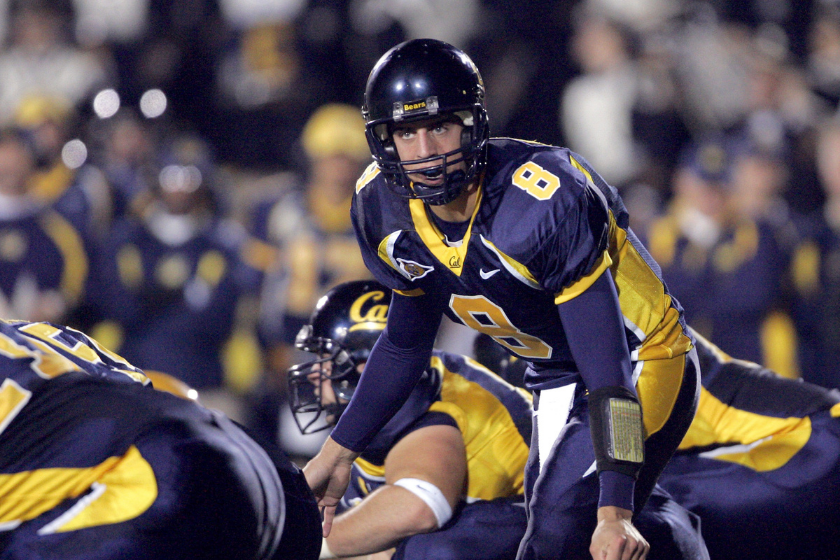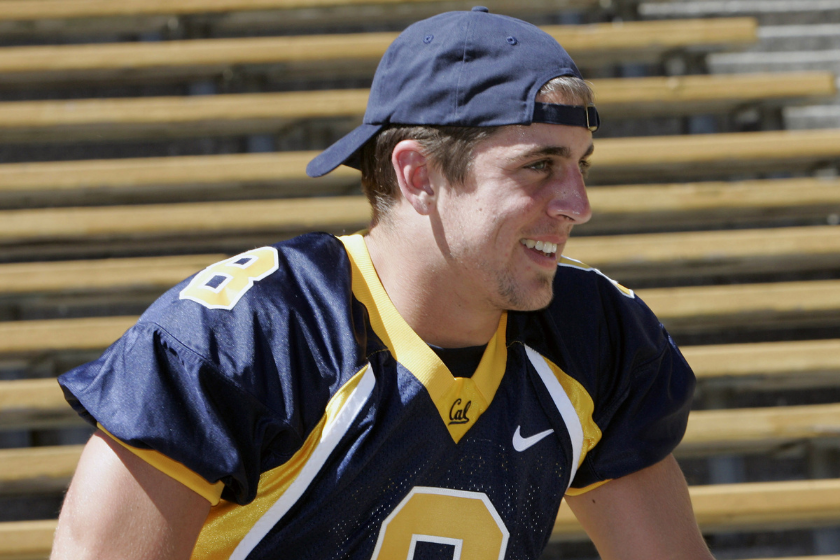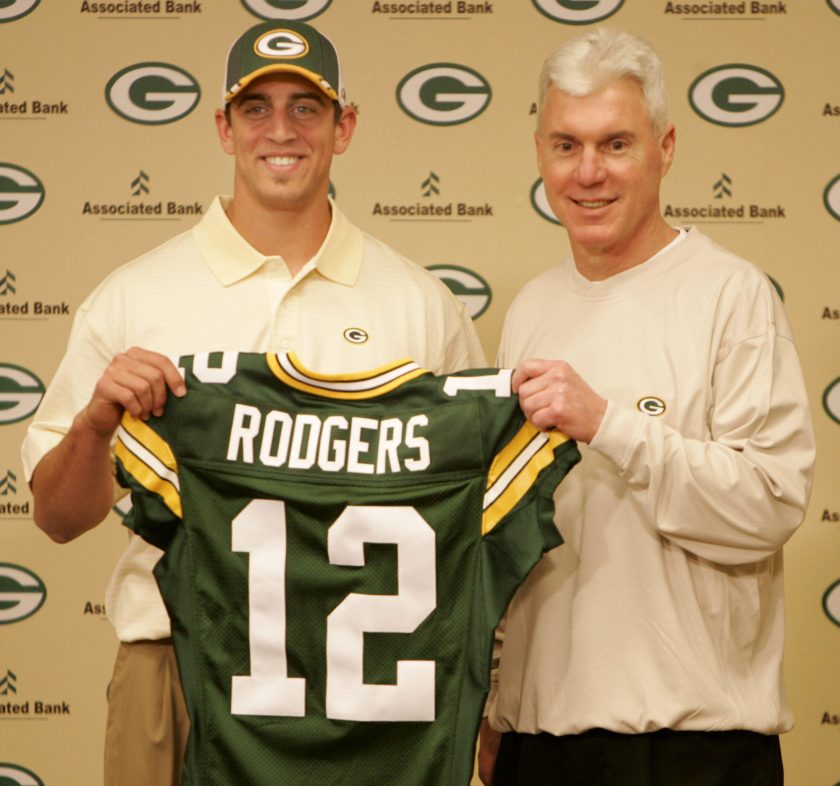Nick Saban, Bill Parcells, Joe Gibbs, Dick Vermeil, Ozzie Newsome, Al Davis and Jon Gruden have one very specific moment of failure in common. They all missed on Aaron Rodgers. Yes, arguably the greatest coach in college football history, six Pro Football Hall of Famers coaches and executives with a combined 11 Super Bowl rings, and another Super Bowl-winning coach who built a career based on being an offensive genius/quarterback expert all passed on one of the most successful quarterbacks in NFL history during the first round of the 2005 NFL Draft, otherwise known as "the Aaron Rodgers Draft." The only other quarterback to drop this far and prove his doubters wrong? Lamar Jackson.
Videos by FanBuzz
They didn't just miss, mind you. They whiffed like they were at a Cinco de Mayo party trying to hit a piñata after being blindfolded, throwing down six shots of Patrón apiece and chasing those shots with a six-pack of Modelo.
Yes, that's some egregious product placement. That's how egregious the miss was on Green Bay Packers legend and current savior of the New York Jets, Aaron Rodgers.
And as the Jets' touchdown of an Aaron Rodgers trade has already begun to shake up mock drafts ahead of the 2023 event, we thought now would be a great time to see where the now-AFC QB could have landed, if certain general managers actually had the wherewithal to select the future Hall of Famer.
While there are many fascinating stories about quarterbacks falling in NFL Draft history, ranging from Johnny Unitas to Joe Montana to Tom Brady, the story of Rodgers going through a free fall was a tad more staggering when you consider that he was a known quantity.
How Aaron Rodgers Fell So Far in the NFL Draft
Coming into that draft, there was a relatively healthy debate about who was going to be the No. 1 overall pick between Rodgers and fellow quarterback Alex Smith, who ended up going to San Francisco with the top draft pick. Smith and Rodgers were considered extremely close at the time and there were plenty of teams at the top of the draft that needed quarterbacks.
But after Smith went No. 1, Rodgers sat on the board until pick 24 when Green Bay took him. The Packers did that despite having Brett Favre and despite not scouting Rodgers very well (more on that in a second). Rodgers spent four hours stewing in the green room and even walked around the Jacob Javits Center in New York, where the draft was held by the NFL. The moment was considered humiliating for Rodgers, who admitted later to using it as motivation to get better.
"Not as disappointed as the 49ers will be that they didn't draft me," he responded, when asked about the 49ers passing on him. The moment was cemented in history from then on, as ESPN re-rolls the footage every single year.
Thankfully, a handful of teams didn't get the chance to miss out on the Wisconsin sports legend. The New England Patriots, Philadelphia Eagles, New York Giants, Seattle Seahawks and Pittsburgh Steelers were never given the chance to pass on Rodgers, but it's not like that's any consolation for having to play him over his lengthy NFL career.
Here's a look back at how the Aaron Rodgers Draft unfolded.
No. 1 San Francisco 49ers
The San Francisco 49ers were in the beginning of a massive rebuild. Coach Mike Nolan and GM Scott McCloughan weren't just looking for a quarterback, they were looking for a guy who was going to be mentally tough enough to withstand the issues that faced them. Smith had proved that at Utah, surviving there despite the best efforts of then-Utah coach Urban Meyer to run him off the team. Literally, Meyer told NFL scouts that he tried to do everything he could to get Smith to leave, but Smith wouldn't budge. Meanwhile, Rodgers came off as prickly and egotistical in meeting with the 49ers, making the team worry about how he'd react to failure.
Also of note, the 49ers would also selected Frank Gore just outside of the second round, cementing his status as a steal in this draft.
No. 2 Miami Dolphins
Saban had made a triumphant return to the NFL after the Dolphins convinced him to leave LSU. The return didn't last long and most people blame the decision to take Daunte Culpepper over Drew Brees in the 2006 offseason as the main reason. Well, the decision to take running back Ronnie Brown over Rodgers was every bit as bad. Brown was a nice player, but he exemplified Saban's short-term thinking at the time. Saban wanted to build a tough-minded team that could run and play defense. He thought the combination of Gus Frerotte and Sage Rosenfels was enough at quarterback. Saban has since learned a thing or two about quarterbacks.
No. 3 Cleveland Browns
Like the Dolphins and Miami, the Browns had gone through a regime change by bringing in coach Romeo Crennel and GM Phil Savage. Like the Dolphins and 49ers, the Browns needed a quarterback. Like the Dolphins, the Browns went with another position, taking uber-talented wide receiver Braylon Edwards out of Michigan.
No. 4 Chicago Bears
The Bears had selected quarterback Rex Grossman in the first round of the 2003 draft and were building around him. Texas running back Cedric Benson was viewed as a complement to Grossman.
No. 5 Tampa Bay Buccaneers
This is where things get fascinating. Jon Gruden had made it clear to people that he wanted Smith at quarterback. He loved Smith's toughness and intelligence. Smith reminded Gruden a lot of Rich Gannon, who Gruden had in Oakland during his first stint with the Raiders. The Buccaneers' quarterback depth chart was Brian Griese, Luke McCown and Chris Simms. Despite the obvious need, Gruden passed on Rodgers because — in a shocking twist of irony — Gruden thought Rodgers was too egotistical and that he was merely a system quarterback created by the offense of Cal coach Jeff Tedford.
No. 6 Tennessee Titans
The Titans had quarterback Steve McNair, who was only 32 and had won the MVP award in 2003.
No. 7 Minnesota Vikings
Related: The 10 Teams With The Worst NFL Draft Records Can Turn A Top Pick Into Mr. Irrelevant
The Vikings had Daunte Culpepper at quarterback, had just traded Randy Moss to Oakland for this pick and wanted desperately to replace Moss. They took Troy Williamson, who had similar speed to Moss. That's where the similarities ended.
No. 8 Arizona Cardinals
Cardinals coach Dennis Green had previously had a good run in Minnesota with a series of retread quarterbacks, such as Warren Moon and Randall Cunningham. That's also because his offense had the likes of wide receiver Cris Carter, running back Robert Smith and a stacked offensive line. Like Miami, Cleveland and Tampa Bay, this was a huge whiff.
No. 9 Washington Commanders
This marks the first Hall of Famer to miss on Rodgers. Coach Joe Gibbs and Washington had two first-round picks (this one and No. 25). They also had a need at quarterback, but Gibbs had fallen in love with Auburn's Jason Campbell. Campbell was a classic pocket passer in the mold of Doug Williams and Mark Rypien, who Gibbs had previously won Super Bowls with. Washington took Carlos Rogers here and then took Campbell at 25, one pick after Rodgers. That's as close as the comparison of Rodgers and Campbell will ever get.
No. 10 Detroit Lions
The Lions had taken quarterback Joey Harrington with the No. 3 overall pick in the 2002 draft and still believe Harrington had a chance to be great. This is why they are the Lions.
No. 11 Dallas Cowboys
Bill Parcells was in his third season of rebuilding the Cowboys and had picks 11 and 20. He also had just signed Drew Bledsoe and had undrafted free agent Tony Romo on the depth chart. That sounds good, but it doesn't take into account that Bledsoe had just been dumped by New England and then Buffalo and that Romo, while talented, was undersized. Parcells did take pass rusher DeMarcus Ware at this spot and Ware will one day be in the Pro Football Hall of Fame, but his pick at 20 was more questionable (we'll get to that).
No. 12 San Diego Chargers
This was the beginning of seven straight picks where Rodgers had almost no shot to be drafted. In this case, it was extremely logical. The Chargers had Brees and Philip Rivers at quarterback. Instead the Chargers used their two first round picks to take Shawne Merriman from Maryland and defensive tackle Luis Castillo from Northwestern.
No. 13 New Orleans Saints
Sometimes choices are about perspective. The Saints had just gone 9-7 in 2002, 8-8 in 2003 and 8-8 in 2004. For the Saints of that time, that was pretty successful. They also had no idea that Hurricane Katrina was going to come through months later and change the trajectory of the team. At the time, the Saints thought they just needed a good offensive lineman and went with Jammal Brown.
No. 14 Carolina Panthers
The Panthers had made the Super Bowl in 2004 and were still riding pretty high, thinking they were only a piece or two away from winning a championship. They took linebacker Thomas Davis, who had a terrific career, and returned to the playoffs.
No. 15 Kansas City Chiefs
Dick Vermeil became the third Hall of Fame coach to pass on Rodgers. In Vermeil's defense, the Chiefs had one of the best offenses in the league with the likes of Hall of Fame tight end Tony Gonzalez, fantasy football favorite Priest Holmes and quarterback Trent Green. They desperately needed a defense and took linebacker Derrick Johnson, who had a very good career.
No. 16 Houston Texans
The Texans had taken quarterback David Carr with the No. 1 overall pick in 2002 and still had hope. The hope was eventually dashed, but that was because the Texans could never protect Carr.
No. 17 Cincinnati Bengals
The Bengals had taken Carson Palmer with the No. 1 overall pick in 2003.
No. 18 Minnesota Vikings
Again, the Vikings had Culpepper. They didn't know that he was going to suffer a brutal knee injury in 2005 and then beg off to head to Miami. They took Erasmus James, who had a forgettable career.
No. 19 St. Louis Rams
Oh, how history might be different. The Rams were desperately hanging on to the last vestiges of the Greatest Show on Turf with Marc Bulger at quarterback and Mike Martz at head coach. While Martz was an offensive visionary, he was not a visionary when it came to Rodgers. Martz was gone after the 2005 season. If he had taken Rodgers, there might have been reason to keep Martz, recreate the Greatest Show, and maybe somehow keep the Rams in St. Louis. You never know.
No. 20 Dallas Cowboys
It was about at this time that Rodgers took a walk around the Javits Center, trying to clear his head after having been cooped up in the green room for so long. It wasn't a great idea. Rodgers was surrounded by reporters asking about his state of mind. But it wasn't as bad an idea as what Parcells came up with for the second of Dallas' two first rounders. Parcells always loved big linemen and hated prima donna quarterbacks. Rodgers had come off as a prima donna before the draft and the 6-foot-4, 315-pound Marcus Spears was sitting there. Spears ended up having a decent career. He wasn't Rodgers, though.
No. 21 Jacksonville Jaguars
The Jaguars took a quarterback here. The only problem is that they took Matt Jones of Arkansas, thinking they could turn him into a wide receiver. Oy.
No. 22 Baltimore Ravens
The Ravens already had Kyle Boller, Rodgers' predecessor as starter at Cal. Boller was taken in the first round in 2003. That said, Boller had already shown a lot of ghastly tendencies, some of which worked against Rodgers. Boller was a system quarterback under Tedford, who covered those bad tendencies. Bottom line is that Newsome and the Ravens weren't ready to make another investment at quarterback.
No. 23 Oakland Raiders
The great Al Davis had one tragic flaw: He was terrible at picking quarterbacks in the first round. Marc Wilson, Todd Marinovich and JaMarcus Russell define the spectrum of bad to awful. The missed chance to take Rodgers by instead taking cornerback Fabian Washington ranks right with those other picks as incredibly bad and marked one of the low points in a decade of losing after Oakland's 2002 Super Bowl run.
No. 24 Green Bay Packers
Rodgers' free fall came to an end here, but it was touch and go. In a lot of ways, the Packers weren't prepared for this pick. Offensive coordinator Tom Rossley had attended Rodgers' workout, but spent most of the workout on the phone and didn't pay attention to Rodgers throwing. Rossley reported back to GM Ted Thompson that Rodgers didn't have a strong arm. When Thompson ran that review by another GM he trusted, the other GM laughed and said, "Ted, arm strength is the last thing you have to worry about with this guy." While it would take Rodgers three years of waiting behind Favre, this moment ended his day of humiliation.
The rest of the draft is about as mixed as the previous picks. University of Alabama-Birmingham's Roddy White would be selected by the Falcons, Logan Mankins would be taken by New England, and Ohio State's Maurice Clarett would be taken in the third round.
But regardless, to this day, this NFL Draft will always belong to Aaron Rodgers.
